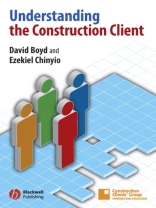This book breaks new ground by creating a framework to understand clients’ actions and needs. Most construction management books focus on improving the construction process; this one focuses on a better engagement with the client. It challenges conceptions of both the construction industry and clients’ businesses so that a more effective process and greater client satisfaction can be achieved. The book suggests that ‘buildings are not about building but about changing and developing the client’. The technical, organisational and psychological aspects of this are described and analysed in detail so that current experience can be explained and better practice determined.
The book offers well-researched information about clients in a number of sectors – developers, supermarkets, NHS, government, airports and housing associations – which will help you understand what these client’s business or service needs are and how construction fits into this. It demonstrates how to develop an appreciation of the client’s perspective with a toolkit for ensuring successful client engagement. This makes Understanding the Construction Client a user-friendly and practical guide, as well as significant text for academia.
Table of Content
Foreword vii
Graham Farrant, Chair CCG
Preface: buildings are not about building! x
Chapter 1 Clients in Perspective 1
1.1 Introduction 1
1.2 The nature of the problem 2
1.3 The categories of clients 4
1.4 What clients want 10
1.5 A problem of delivery 14
1.6 Structure of this book 16
1.7 A concluding remark 18
References 19
Chapter 2 A Model of Clients 23
2.1 Introduction 23
2.2 The basic thesis 25
2.3 A model of clients 26
2.4 Fundamental awarenesses and the model 30
2.5 Model for sector analysis 32
2.6 Summary 35
References 35
Chapter 3 The Client at Rest 37
3.1 Client’s knowledge and processes 37
3.2 Clients see the world differently 40
3.3 Organisational knowns 44
3.4 Normal organisational unknowns 54
3.5 People in organisations 64
3.6 Conclusions 71
References 71
Chapter 4 The Client in Change 75
4.1 The project means and ends 75
4.2 Means and ends as values 77
4.3 Building involves organisational change in the client 84
4.4 Building involves unknowns that are unformed 87
4.5 Emotion of change 91
4.6 Change creates gaps and contradictions 93
4.7 Means and ends of engagement 96
4.8 What is to be done? 111
References 111
Chapter 5 Property Developers as Clients 114
5.1 Introduction 114
5.2 Business environment of property development 116
5.3 Finance and risk of projects 123
5.4 Business constitution: strategy to operations 125
5.5 Experience of building: from unknowns and contradictions to means and ends 132
5.6 Key issues 144
References 145
Resources 145
Chapter 6 Supermarkets as Clients 147
6.1 Introduction 147
6.2 The business environment: strategy in the world 148
6.3 Business structure and processes: the tactical plan 152
6.4 Business operation 155
6.5 Experience of building: from unknowns and contradictions to means and ends 158
6.6 Key issues 161
References 162
Resources 162
Chapter 7 NHS Acute Trusts as Clients 163
7.1 Introduction 163
7.2 The environment of NHS acute trusts 169
7.3 Experience of building: from unknowns and contradictions to means and ends 181
7.4 Means and ends of building 187
7.5 Key issues 189
References 190
Resources 191
Chapter 8 Governments as Clients 192
8.1 Introduction 192
8.2 The political domain: service in a political environment 193
8.3 The managerial domain 205
8.4 The operational domain 209
8.5 Experience of building: from unknowns and contradictions to means and ends 214
8.6 Key issues 219
References 219
Resources 220
Chapter 9 Airports as Clients 221
9.1 Introduction 221
9.2 Business environment of airports 225
9.3 Business structure processes and operations 235
9.4 Experience of building: from unknowns and contradictions to means and ends 239
9.5 Key issues 244
References 245
Resources 246
Chapter 10 Housing Associations as Clients 247
10.1 Introduction 247
10.2 Business environment of housing associations 250
10.3 Management of housing associations 255
10.4 Operations in housing associations 262
10.5 Experience of building: from unknowns and contradictions to means and ends 264
10.6 Key issues 267
References 267
Resources 268
Chapter 11 A Toolkit for Engagement 269
11.1 Introduction 269
11.2 Outline of toolkit 272
11.3 Working with clients’ change processes 274
11.4 Understanding the client’s business 288
11.5 Managing the industry’s fragmentation 293
11.6 Developing the approach 294
11.7 Conclusion 297
References 297
Chapter 12 Postscript 299
Reference 302
Appendix: The Interviewees 303
Author Index 305
Subject Index 308
About the author
David Boyd is Deputy Head of the School of Property & Construction, University of Central England, Birmingham, UK. Ezekiel Chinyio is based at the Univeristy of Wolverhampton, UK.












